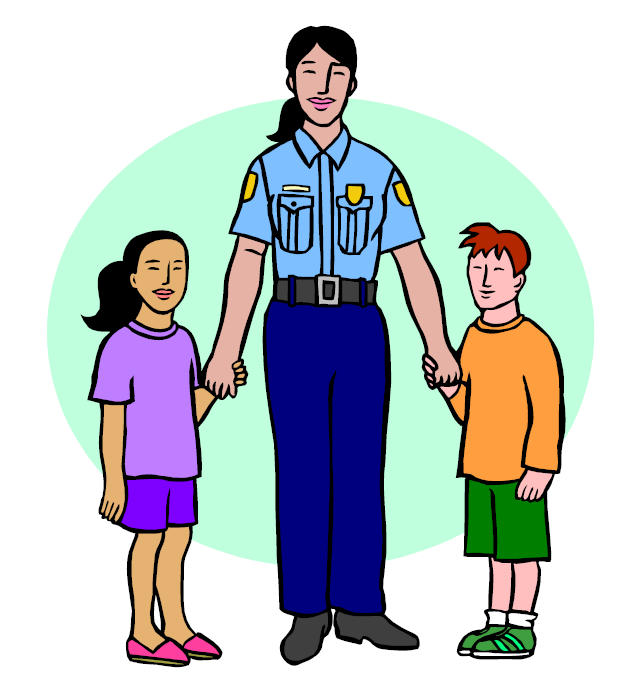Personal Safety for Children and Families
Personal Safety for Children and Families

Family rules
Establishing a system of “family rules” about personal safety can be a good way to teach children to distinguish between safe and a non-safe situation. Many families already have rules about bedtime, TV watching, chores, etc. By adopting rules about personal safety, parents can teach good habits through reinforcement and repetition without generating excessive fear. The following are suggestions for personal safety rules that can be incorporated into a family routine.
Inside rules
- Kids should know their complete home address, telephone number including area code and parents’ first and last names.
- If kids are old enough to answer the phone, they should know how to call 9-1-1. Practice with the receiver button taped down.
- Kids should be taught never to reveal any personal (their name, school, age, etc.) or family information over the phone unless a parent has given permission.
- If kids are home alone and answer a phone call for an absent parent, they should say “she can’t come to the phone right now”, and take a message or tell the caller to try later – don’t make excuses, they sound phony.
- It’s okay not to answer the phone, or to work out a code (ring twice, hang up call again) so parent can check on a child that is home alone.
- Kids are old enough to answer the door when they are old enough to check the identity of the person at the door WITHOUT opening it.
- Kids should help their parents make sure doors that should be locked are locked.
Outside Rules
- Establish a system of accountability. Learn the full names of your kids’ friends, their parents’ names, addresses and phone numbers. Check to verify the accuracy if you get the information from your kids. When your child is at a friend’s home, who else is present? Parents? Older kids? Other neighbors? No one?
- Know your child’s routes to and from school, play and errands. Insist they stick to the same route – no shortcuts! If you have to look for them, you will know where to begin.
- Kids should be taught never to go anywhere with anyone without parental permission. This includes getting permission a second time if plans change and calling to check before going from one friend’s home to another location.
- Kids should never play in isolated areas of parks or playgrounds, and should avoid public restrooms, building sites and dark streets.
- Teach kids alternatives; if they are bothered or followed on the playground, walking to friends’ home, school or store, where do they go? Walk these common routes with your child and look for choices. Can they go back into the school, in a store or business (kids are reluctant to enter a strange store or business unless given permission,) into a fire station or approach someone doing yard work?
- Knocking on the door of a stranger is a last resort. If they have no other choice they should look for a house with a light on (at night) or toys in the yard if possible and ask the homeowner to “please call the police, someone is bothering me”, but not to go inside the house.
- Kids’ best defenses are their voices and their legs. Teach them to runaway from someone who is bothering them while yelling to attract as much attention as is possible.
- Have them practice yelling!
- Teach kids not to approach cars that stop to ask for help. Most legitimate adults would not ask a young child for directions anyway. If the car follows them or the driver gets out they should run away and yell.
“Bad Guy” Rules
- Teach kids that “bad guys” can be anyone; society teaches kids bad guys are always ugly, mean and scary, and look like monsters. Bad guys are almost always portrayed as strangers and as men.
- Remember, a stranger is someone who is not known by the child. A friend of parents, a friend of the child’s friend or a neighbor can be a stranger. And a stranger can be a good guy or a bad guy.
- Some bad guys act nice, friendly and are attractive. Some bad guys play tricks on kids. Typical bad guy tricks include bribes (money, toys, games, or promises of those things), lies (your mom told me to pick you up at school), requests for help (my puppy ran away, can you help me find him?), or threats (if you don’t come with me I’ll hurt your mom).
- Teach kids that a bad guy is someone who asks them to violate family rules, e.g. someone who says they don’t need permission to accompany them.
- Develop a family “code word”. If someone other than a parent is going to pick up a child unexpectedly, that person should repeat the “code word” first before the child agrees to leave. The code word should remain a secret and be changed should others learn of it. Schools have specific rules about “emergency pick-ups”. Please make sure you are aware of those rules and provide the school with the information needed.
* Adapted from the Seattle Police Department Crime Prevention Section website
